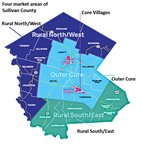

SULLIVAN COUNTY –– Housing has been an issue County officials have been intent on addressing.
The County recently contracted with czb LLC, a Virginia-based urban planning and community development firm, to assist in developing a comprehensive housing strategy.
During Thursday’s Health and Human Services Committee meeting, Deputy Commissioner of Planning, Community Development and Real Property Jill Weyer and Division of Health and Human Services Commissioner John Liddle presented the draft study, which focuses on four key findings, to legislators and members of the public.
The first is that the County is not one housing market, but that there are at least four distinct markets - Rural North/West, Outer Core, Core Villages and Rural South/East (see photo).
The study reports that distressed housing and concentrated poverty in the core villages are a constraint on those villages, but also a challenge for the County as a whole. It also states that high shares of seasonal units in the Outer Core and Rural North/West pose growing risks to market stability, and that there are fewer risks in the South/East due to commuter appeal.
Furthermore, mobile homes were found to be a significant source of affordable housing beyond the core villages.
Home affordability/rental supply
The second key finding of the draft study is that home prices in Sullivan County, which have risen an average of 38 percent since the start of 2020 ($168,198 to $232,327), are “still broadly affordable,” and reflect “significant liabilities and challenges.”
Potential vulnerabilities for the homeownership market going forward, according to the study, are the large inventory of homes that need significant work; low job densities; location liabilities; few schools with above-average ratings; and that villages have limited marketability.
This led into the third key finding which is that rental housing is in short supply, especially units in good condition. This is causing what Liddle calls a “compression towards the middle.” Liddle explained that families with two middle class incomes are taking rentals that are probably below what they could afford because that’s what’s available.
“What that’s doing is driving up rent prices for folks on the lower end that normally would be going into those kinds of units,” said Liddle, adding that it’s also hurting the people the County serves in social services. “While we were able to help a lot of folks into studios and one bedroom [units], what we’re seeing is two and three bedroom [units] for a family group of five people gets much more difficult. So this is one of the things that they caught in the study that we’re going to work to address.”
The fourth and final key finding is that without subsidy, new housing is not affordable for households earning less than $75,000.
Moving forward
An online survey was also conducted, which had over 400 responses.
It found that utility/transportation costs, property taxes, and blight ranked highest when survey takers were asked (from a list) which housing issues impacted them personally. Furthermore, 66 percent of respondents agreed that significant local interventions are needed to address high-impact housing issues.
Sullivan County’s housing priorities, as determined in the study, include prioritizing limited resources and capacity; meeting housing needs for households making under $50,000 (which is 44 percent of County households); and to do so in a manner that has wider market impacts/benefits.
Three opportunities listed in the draft study include partnering with landlords to improve 240 existing rental units and preserving the affordability of 80 of those units for households making $20,000 or less; creating forty units of new rental housing priced for households making $20,000-$35,000; and 40 units of new market-rate rental housing priced for households making $35,000-$50,000.
The study also stressed getting the basics right, which it defines as investing in quality of place and infrastructure, seeking mixed-income results, and clustering investments for high impact.
It also recommends pursuing several complementary activities such as extending the life of existing developments that used low income housing tax credits; create and use a list of landlords and investors with troubled histories; boost capacity of code enforcement and compliance assistance; and update land use regulations and capital improvement plans to support housing investments.
Liddle added that feedback local officials gave to the consultants [czb LLC] was to address the emergency housing need, improve blight and single family rehab and affordability, identify potential funding streams for implementation and identify ways to assist code enforcement at the County level.
During the presentation legislators also touched on topics such as the impact short-term rentals are having on the County’s housing market, subsidies, as well as the role of local zoning statutes.
Legislators are expected to vote on whether or not to adopt the proposed comprehensive housing strategy next month.
The entire study can be found on www.sullivanhousingstudy.org.
Comments
No comments on this item Please log in to comment by clicking here